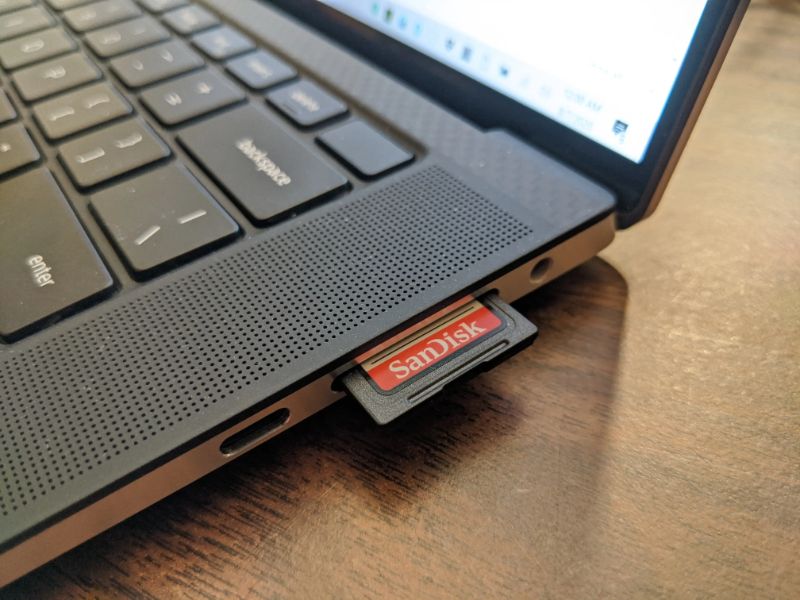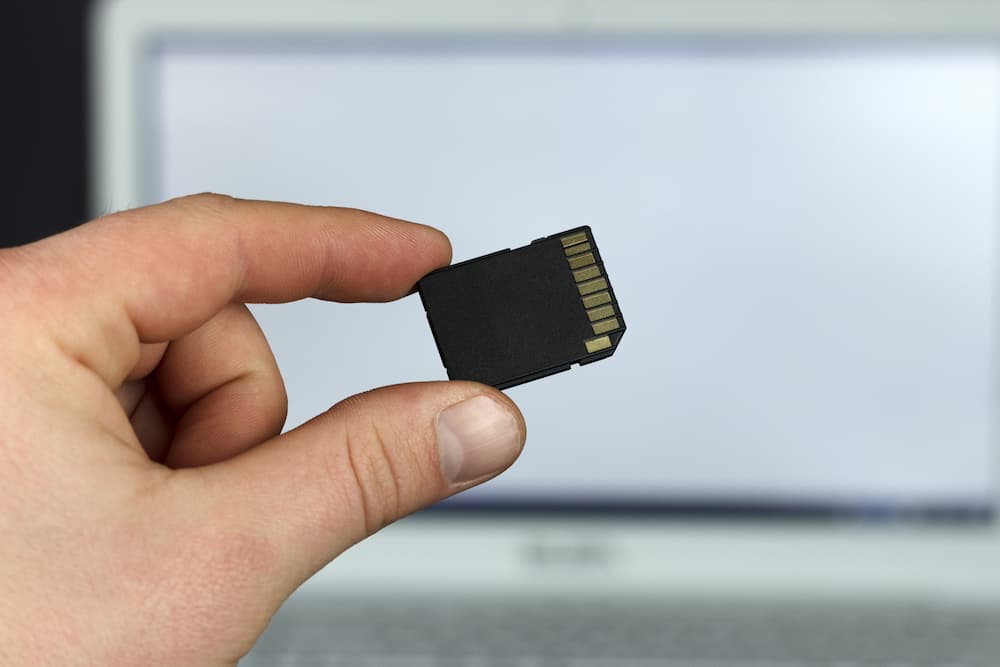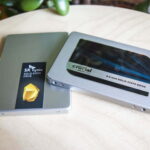
You are in charge of suggesting memory upgrades for the laptop computers in your company.
What kind of memory card does a laptop use?
SO-DIMM is a kind of memory card that a laptop use. The small outline dual inline memory module is ideal for laptop manufacturers who prefer to save space in a laptop form factor because it is roughly half as long as a typical DIMM.
For more information, keep reading.
Table of Contents
What To Know About SD Cards?
The MultiMediaCard (MMC) was replaced by the SD card, which debuted in 1999. It was one of several competing memory card formats used by consumer electronics, including the now-defunct Memory Stick from Sony and the much-less-common CompactFlash card.
The SD card resembles a typical thumbnail in size. Dave Johnson/Business Insider
The original SD card specification has been updated numerous times to accommodate higher capacities as the electronics industry has advanced. That means there are several types of SD cards sold and used today:
- SD: There are no longer any original SD cards available. It utilized the FAT16 file system and had a 2 GB maximum storage capacity.
- SDHC: 2006 saw the introduction of the Secure Digital High Capacity (SDHC) card. It makes use of the FAT32 file system and supports capacities up to 32 GB.
- SDXC: In 2009, the Secure Digital eXtended Capacity (SDXC) format first appeared. On the exFAT file system, it has a maximum storage capacity of 2 TB.
- SDUC: In 2018, Secure Digital Ultra Capacity (SDUC) cards were introduced, each of which can store 128 TB of data using exFAT.
SD Cards For Data Storage
Nowadays, a built-in SD card slot is present in the majority of laptops. It’s primarily made for transferring files between devices or removing photos from cameras, but it can also be used as a quick way to increase storage.
Secondary Data Drives
You can leave the card permanently inserted and essentially use it as a secondary data drive if it sits flush with the laptop’s casing.
Unfortunately, the SD card actually sticks out from the slot on many laptops by a few millimeters, giving it an untidy appearance and making it more likely to snag. There are a few potential solutions in these situations.
Some manufacturers, like the Transcend JetDrive Lite, have SD cards that fit MacBook card slots perfectly. Depending on the case design, they might or might not fit your Windows laptop as well. Just be careful not to insert a card that is too small lest it become stuck and impossible to remove.
Along similar lines are HyperDrive adapters. However, they may also fit Windows laptops. These are once again designed for MacBooks. Because they are shorter than SD cards and do not protrude as far from the slot as SD cards do, these MicroSD card adapters fit into regular SD card slots. You can find generic versions on Ebay, too, often called MiniDrive adapters.
In either case, if you’re using an SD card for storage, you want the fastest, largest card that will fit in your laptop. A minimum of 128 GB and U3 speed are preferred, with the caveat that speed won’t matter as much once all the files have been copied over if you plan to use the card to store something like your iTunes library.

Data Backups
If you can find a card that fits your laptop’s SD slot perfectly, you can leave it inserted as a handy backup drive in conjunction with File History in Windows or Time Machine in OS X.
It’s a better choice if you’re performing selective backups because the size of card you can purchase (e.g. there’s no way to clone a 2 TB drive to an SD card as of right now), and cards start to lose value once you exceed 128 GB.
Raspberry Pi
The Raspberry Pi needs an SD card (or The system installation requirements on a Raspberry Pi 2 are minimal. MicroSD. You need a card of 4 GB or larger to use the NOOBS app which simplifies the installation and setup process, and the official recommendation is 8GB, Class 6.
However, if you must, you can use a USB flash drive for that. You may want to use a larger card so you have room for data storage as well.
However, some users have reported compatibility issues with specific card models, despite the fact that most SD cards ought to function on the Pi. Before you settle on a card, it’s worth checking this list of working and non-working cards to see if yours has been tested.
SD Cards For Bootable Drives
An SD card can also serve as a bootable drive for your laptop or computer. You can set it up for emergencies if your computer fails to boot or if you want to test drive a new Linux distro.
Because many laptops can’t start from the internal SD card slot, you might need to use an adapter and connect it to a USB port. In this case, make sure your adapter is at least USB 3.0 or it will be unusably slow.
To create a Windows 10 boot disk, you only need a card of at least 4 However, there are currently no compelling reasons to purchase a card of this size. Most people can afford and benefit greatly from a 16 GB U1 card.
How to Choose the Right SD Card?
Capacity
The SD Cards come in a wide range of storage capacities, just like all other types of storage media. The range of storage your SD card can handle is determined by three different capacity types.
- The SD Standard Capacity (SDSC) stores from 1 MB to 2 GB.
- The newer SD High Capacity (SDHC) stores from 2 GB to 32 GB.
- And the latest SD Extended Capacity (SDXC) stores 32 GB to 2 TB.
You should be aware of the various capacity types and not just focus on gigabyte or terabyte counts in order to make sure the type is compatible with your device. Your device may only be capable of using the SDHC standard, even if you want a 2 TB SD memory card, which must be an SDXC card.
Speed Class
The speed at which you want to be able to transfer the files from your SD card should also be taken into consideration. However, the SD Association does not actually define the speed with these classes; rather, SD card manufacturers use them as general guidelines.
The speed classes that exist are 2, 4, 6 and 10 with speed Class 10 is the fastest. If you want the best of the best, there are also two Ultra High Speed (UHS) classes. These are primarily intended for professional use.
The precise speed (often expressed in megabytes per second) that your SD card can support should be taken into account with regard to these speed classes to determine whether it meets your needs.
If you don’t care about precise numbers, you may only need to be aware that Class 2 (the slowest) is suitable for recording standard definition video and Class 10 is suitable for recording full HD video. For recording high definition video, the middle classes are suitable.

Physical Size
You should first confirm that your device is compatible with the physical size of an SD card. Standard SD cards, miniSD cards, and microSD cards are all included in the range; details on each are provided below.
- Standard SD cards – These are the biggest cards and weigh about two grams (measurements: 32 mm x 24 mm x 2.1 mm). These dimensions are frequently used in modern digital cameras. Due to the cut in the top right corner, you can identify a standard SD card.
- miniSD cards – MiniSD cards weigh 0.8 g and are smaller than standard ones (21.5 mm x 20 mm x 1.4 mm). This type was created to fit into smaller mobile phones, but it has now largely been replaced by a smaller card size.
- microSD cards – It only weighs 0.25 g and measures 15 mm by 11 mm by 1 mm. Most cell phones that have memory card slots accept cards of this size. It’s also frequently used in tablets and compact action cameras.
The product specifications for your device should specify what types of physical SD card sizes it is compatible with. However, they frequently come with a standard SD card adapter if you use a microSD card. For instance, since laptops primarily support the common SD card size, using multiple memory cards simultaneously is much simpler.
FAQs
What is a SD Card for Laptop?
An SD memory card is an ideal way to save your PC’s data, such as photos, music, emails, software, documents, and apps. Additionally, you can move the data to other gadgets like digital cameras or smartphones, where you can store it for later use.
What Kind of Memory Module Do Most Laptops Use?
Dual In-Line Memory Module
Currently, the most common type of memory module used in PCs is the DIMM (Dual In-Line Memory Module), which is capable of transferring 64 bits of data per cycle. The memory modules used in notebooks can be compared to scaled-down versions of desktop memory modules.
Do I Need a Specific SD Card for My Phone?
You need to make sure that the SD card is compatible with your device. The relative speed, rated speed, and other factors should be taken into consideration as well.
How Long Do SD Cards Last?
10 years
Information is stored in flash memory on SD standards-based memory cards, like the majority of semiconductor cards. The current technology along with normal usage typically gives the card a lifespan of 10 years or more, allowing consumers to upgrade their devices for many years and reduce consumer electronic waste.
Conclusion
There may still be SD card slots on some laptops and desktops. Because laptop sizes have shrunk, some laptops that once had SD card slots no longer do. In order to make their laptops thinner, many laptops have started to replace their standard USB A port with a USB C port. Due to the lack of an SD card slot on their computer, the majority of users simply purchase a cheap SD card adapter for their desktop or laptop computer.
Thank you for reading.








